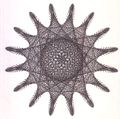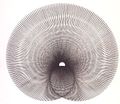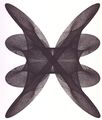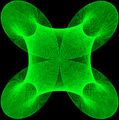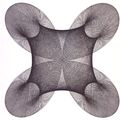Category:Tektronix: Difference between revisions
No edit summary |
rearranged |
||
| Line 3: | Line 3: | ||
All of the designs are based on wide-interval samplings<ref name=note2 /> of sine waves plotted in various different ways. This was a technique I discovered more or less by accident when I mistakenly had the trig functions set to "RAD" (radians) with a plotting program that was designed to work in degrees. | All of the designs are based on wide-interval samplings<ref name=note2 /> of sine waves plotted in various different ways. This was a technique I discovered more or less by accident when I mistakenly had the trig functions set to "RAD" (radians) with a plotting program that was designed to work in degrees. | ||
I wrote the plotting program in BASIC, because that's what was available (I think that was probably the first programming language I actually used successfully | I wrote the plotting program in BASIC, because that's what was available (I think that was probably the first programming language I actually used successfully<ref name=note3 />. I wrote the program in the first place because I wanted to see what shapes you get when plotting various complex sine functions using polar coordinates. (Sine waves are fun. Polar coordinates are also fun.) | ||
==Footnotes== | ==Footnotes== | ||
<references> | <references> | ||
<ref name=note1>I think the model number was something like 3017, though Wikipedia indicates that it was the [[wikipedia:Tektronix 4010|401x series]] which was active at that time -- so maybe it was 4017, 4016, 4015? I don't know if there are any photos... (Update: 4015 is starting to ring a bell, so I think that's what it probably was.)</ref> | <ref name=note1>I think the model number was something like 3017, though Wikipedia indicates that it was the [[wikipedia:Tektronix 4010|401x series]] which was active at that time -- so maybe it was 4017, 4016, 4015? I don't know if there are any photos... (Update: 4015 is starting to ring a bell, so I think that's what it probably was.)</ref> | ||
<ref name=note2>Feel free to ask me to explain what I mean by this.</ref> | <ref name=note2>Feel free to ask me to explain what I mean by this.</ref> | ||
<ref name=note3>A {{l/wp|VT52}} was later added, for those occasions when you | <ref name=note3>: I had tried to write in {{l/wp|FOCAL-69}} in 1972, second grade, but I misunderstood the line-numbering system and my programs all executed out of order... and it's difficult to create any output worth looking at when your output device is a teletype. (A {{l/wp|VT52}} was later added, for those occasions when you don't actually need a complete printed record of your entire debugging session.)</ref> | ||
</references> | </references> | ||
[[Category:Computers|Tektronix]] | [[Category:Computers|Tektronix]] | ||
Revision as of 14:02, 31 March 2017
These were plotted using a Tektronix graphics computer[1] sometime between 1975 and 1978 or so.
All of the designs are based on wide-interval samplings[2] of sine waves plotted in various different ways. This was a technique I discovered more or less by accident when I mistakenly had the trig functions set to "RAD" (radians) with a plotting program that was designed to work in degrees.
I wrote the plotting program in BASIC, because that's what was available (I think that was probably the first programming language I actually used successfully[3]. I wrote the program in the first place because I wanted to see what shapes you get when plotting various complex sine functions using polar coordinates. (Sine waves are fun. Polar coordinates are also fun.)
Footnotes
- ↑ I think the model number was something like 3017, though Wikipedia indicates that it was the 401x series which was active at that time -- so maybe it was 4017, 4016, 4015? I don't know if there are any photos... (Update: 4015 is starting to ring a bell, so I think that's what it probably was.)
- ↑ Feel free to ask me to explain what I mean by this.
- ↑ : I had tried to write in FOCAL-69 in 1972, second grade, but I misunderstood the line-numbering system and my programs all executed out of order... and it's difficult to create any output worth looking at when your output device is a teletype. (A VT52 was later added, for those occasions when you don't actually need a complete printed record of your entire debugging session.)
Media in category "Tektronix"
The following 12 files are in this category, out of 12 total.
-
1983-01-01 1414 Tektronix vaguely figure-8ish shape - felt-tip.1200pxw.jpg 1,200 × 1,803; 1.05 MB
-
Tektronix 16-pointed star - Rapidograph.1200pxw.jpg 1,200 × 1,194; 549 KB
-
Tektronix cardioid Rapidograph slow.1200pxw.jpg 1,200 × 1,043; 604 KB
-
Tektronix folded shape - felt-tip.png 2,102 × 1,629; 2.75 MB
-
Tektronix folded tetrafoil Rapidograph slow.crop.png 1,866 × 1,249; 4.49 MB
-
Tektronix folded tetrafoil Rapidograph slow.green-on-black.png 1,972 × 1,315; 4.38 MB
-
Tektronix split tetrafoil Rapidograph slow.jpg 2,196 × 2,586; 1.73 MB
-
Tektronix tetrafoil Rapidograph slow.2015-crop-adj.jpg 2,065 × 2,076; 3 MB
-
Tektronix tetrafoil Rapidograph slow.original.jpg 2,137 × 2,137; 1.99 MB
-
Tektronix xmas star - red felt-tip.cleaned.xp.png 2,208 × 1,925; 1.83 MB
-
Wooz-dev-logo.take 1.crop.1200pxw.png 1,200 × 823; 1.59 MB

